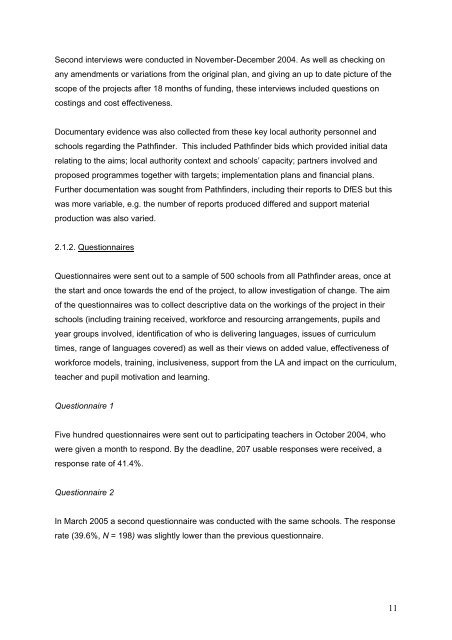Evaluation of the Key Stage 2 Language Learning Pathfinders
Evaluation of the Key Stage 2 Language Learning Pathfinders
Evaluation of the Key Stage 2 Language Learning Pathfinders
Create successful ePaper yourself
Turn your PDF publications into a flip-book with our unique Google optimized e-Paper software.
Second interviews were conducted in November-December 2004. As well as checking onany amendments or variations from <strong>the</strong> original plan, and giving an up to date picture <strong>of</strong> <strong>the</strong>scope <strong>of</strong> <strong>the</strong> projects after 18 months <strong>of</strong> funding, <strong>the</strong>se interviews included questions oncostings and cost effectiveness.Documentary evidence was also collected from <strong>the</strong>se key local authority personnel andschools regarding <strong>the</strong> Pathfinder. This included Pathfinder bids which provided initial datarelating to <strong>the</strong> aims; local authority context and schools’ capacity; partners involved andproposed programmes toge<strong>the</strong>r with targets; implementation plans and financial plans.Fur<strong>the</strong>r documentation was sought from <strong>Pathfinders</strong>, including <strong>the</strong>ir reports to DfES but thiswas more variable, e.g. <strong>the</strong> number <strong>of</strong> reports produced differed and support materialproduction was also varied.2.1.2. QuestionnairesQuestionnaires were sent out to a sample <strong>of</strong> 500 schools from all Pathfinder areas, once at<strong>the</strong> start and once towards <strong>the</strong> end <strong>of</strong> <strong>the</strong> project, to allow investigation <strong>of</strong> change. The aim<strong>of</strong> <strong>the</strong> questionnaires was to collect descriptive data on <strong>the</strong> workings <strong>of</strong> <strong>the</strong> project in <strong>the</strong>irschools (including training received, workforce and resourcing arrangements, pupils andyear groups involved, identification <strong>of</strong> who is delivering languages, issues <strong>of</strong> curriculumtimes, range <strong>of</strong> languages covered) as well as <strong>the</strong>ir views on added value, effectiveness <strong>of</strong>workforce models, training, inclusiveness, support from <strong>the</strong> LA and impact on <strong>the</strong> curriculum,teacher and pupil motivation and learning.Questionnaire 1Five hundred questionnaires were sent out to participating teachers in October 2004, whowere given a month to respond. By <strong>the</strong> deadline, 207 usable responses were received, aresponse rate <strong>of</strong> 41.4%.Questionnaire 2In March 2005 a second questionnaire was conducted with <strong>the</strong> same schools. The responserate (39.6%, N = 198) was slightly lower than <strong>the</strong> previous questionnaire.11

















